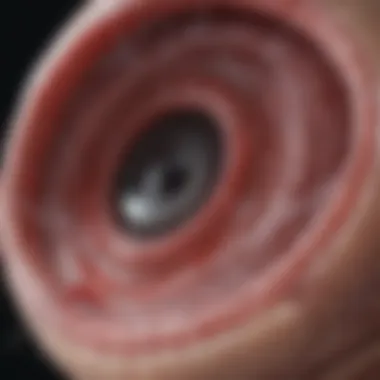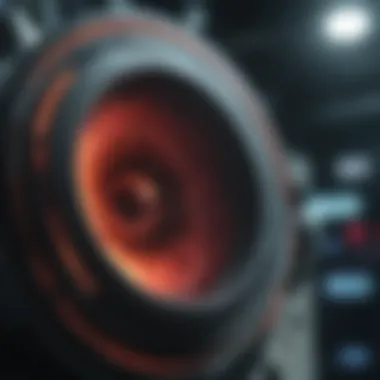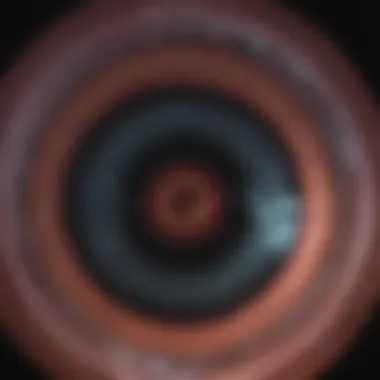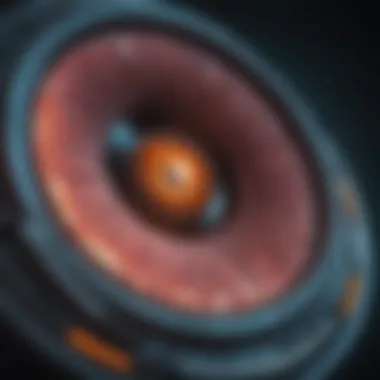IVUS Guided PCI: Imaging and Intervention Synergy


Intro
Percutaneous Coronary Intervention (PCI) has long been a cornerstone in the management of coronary artery disease. However, integrating Intravenous Ultrasound (IVUS) technology into PCI procedures adds a new dimension of precision and effectiveness. This synergy enhances the clinician’s ability to visualize and assess coronary arteries before, during, and after intervention. This article will address the critical components of IVUS guided PCI, offering insights into its operational framework, the benefits it brings to the clinical setting, and future directions for this evolving field.
Research Overview
Summary of Key Findings
The literature surrounding IVUS and its role in PCI reveals several important findings. Firstly, studies demonstrate that IVUS guided approaches lead to improved procedural outcomes when compared to traditional methods. This includes reduced rates of complication and increased success in achieving optimal stent deployment. Moreover, IVUS allows for a three-dimensional mapping of the arterial anatomy, enabling more informed decisions regarding interventions.
Key findings include:
- Enhanced visualization of arterial structures.
- Increased efficacy in stent placement.
- Lower rates of adverse clinical events post-procedure.
Relevance to Current Scientific Discussions
The integration of IVUS technology into PCI highlights a critical junction in cardiovascular care. Current discussions emphasize the potential for IVUS to make interventions more personalized. By understanding artery characteristics in real-time, clinicians can tailor their strategies to individual patient needs. Furthermore, as technology in imaging and procedures continues to advance, the role of IVUS will likely expand, contributing to improved outcomes across broader patient demographics.
Methodology
Research Design and Approach
This exploration employs a multi-faceted approach. Integrating both qualitative and quantitative research methods, it examines case studies alongside statistical data from various clinical trials. A systematic review of existing literature is conducted to synthesize findings and identify best practices.
Data Collection and Analysis Techniques
Data collection for this study draws from diverse sources, including:
- Clinical trial results from medical journals.
- Patient outcome data from hospitals.
- Expert interviews with leading cardiovascular specialists.
Data analysis includes statistical comparison of procedural outcomes with and without IVUS utilization, further illuminating the technology's impact on patient care.
"The meticulous use of IVUS technology in PCI stands as a testament to the evolution of cardiovascular interventions, urging the medical community to embrace precision in every surgical aspect."
Through this structured inquiry, the article seeks to present a comprehensive understanding of IVUS guided PCI, establishing it as a pivotal advancement in the realm of cardiovascular medicine.
Foreword to IVUS Guided PCI
Understanding IVUS guided Percutaneous Coronary Intervention (PCI) is essential for both practitioners and scholars in cardiovascular medicine. This technique not only enhances the precision of the intervention but also improves patient safety and outcomes. Over the years, integration of imaging technologies like intravascular ultrasound (IVUS) has transformed the landscape of PCI, allowing clinicians to visualize coronary artery anatomy in real time. This aids in the assessment of lesion characteristics before, during, and after stenting procedures.
The rise of IVUS guided PCI signifies a shift towards a more nuanced approach in cardiac interventions. Practitioners now have a powerful tool that can influence clinical decision-making, providing invaluable information regarding the size and nature of arterial lesions. This is crucial since the success of PCI largely hinges on the accurate identification and treatment of these lesions. By delving deeper into the nuances of IVUS technology, medical professionals can better understand how imaging impacts various stages of PCI.
Overview of Percutaneous Coronary Intervention
Percutaneous Coronary Intervention (PCI) is a minimally invasive procedure used to treat narrowing of the coronary arteries. This narrowing is mainly caused by atherosclerosis, where plaque builds up and obstructs blood flow. During PCI, a catheter with a balloon at its tip is inserted into the blood vessel and is guided to the site of the blockage. Once positioned, the balloon is inflated to widen the artery. In many cases, a stent is placed to keep the artery open.
The procedure has become a cornerstone in the management of coronary artery disease due to its effectiveness and relatively brief recovery time compared to surgical alternatives. However, the procedure is not without risks. Appropriate selection of candidates and precise execution during the intervention are critical for achieving optimal outcomes. Here, imaging technologies like IVUS can provide critical insights into arterial morphology, helping to mitigate risks and ensure better decision-making.
The Significance of Imaging in Cardiology
Imaging plays a pivotal role in modern cardiology. It improves diagnostic accuracy and guides intervention strategies. Advanced imaging techniques, particularly IVUS, enable clinicians to visualize the inner structures of blood vessels with remarkable detail. This visualization is crucial in determining lesion morphology, which can inform treatment choices such as stent selection and deployment techniques.


Key advantages of imaging integration in PCI include:
- Enhanced Visualization: IVUS provides real-time images that reveal vessel dimensions and plaque characteristics.
- Improved Decision-Making: Detailed images allow for more informed surgical decisions, potentially leading to better patient outcomes.
- Assessment of Interventional Success: Post-procedural imaging can confirm successful stent placement and identify complications like restenosis.
In summary, the synergy between imaging and intervention in cardiology not only enriches the procedural understanding but also enhances overall patient management. The commitment to integrating imaging into PCI signifies a progression towards a more meticulous and patient-centered approach in cardiovascular care.
Fundamentals of Intravenous Ultrasound
Understanding the fundamentals of Intravenous Ultrasound (IVUS) is crucial for grasping how this advanced imaging technique enhances Percutaneous Coronary Intervention (PCI). IVUS provides high-resolution images of the coronary arteries. This allows clinicians to visualize the interior of blood vessels, assess lesion characteristics, and guide interventions with precision. The importance of these fundamentals lies in their direct impact on clinical outcomes. By having detailed insights into vascular morphology, it becomes possible to make more informed decisions during interventions.
Technical Aspects of IVUS
The technical aspects of IVUS involve sophisticated equipment and methodologies designed to obtain clear images of the coronary arteries. At the heart of this technology lies a catheter embedded with a transducer. This device emits ultrasound waves and collects the backscattered signals as they return after interacting with tissue structures.
A key feature is the resolution and depth of penetration provided by IVUS. The ability to visualize structures as small as the intimal layer of the artery contributes significantly to assessing plaque burden and vascular remodeling. The method is mostly real-time, allowing for dynamic imaging as the catheter navigates through the arteries.
Additionally, factors like frequency of the ultrasound waves affect image quality. Higher frequencies generally yield better resolution but have reduced penetration. Conversely, lower frequencies penetrate deeper but provide lower resolution images. Understanding these balances allows caregivers to optimize imaging for specific clinical scenarios.
Types of IVUS Systems
There are different types of IVUS systems, each tailored for specific clinical settings. These systems vary based on imaging capabilities, ease of use, and cost.
- Standard IVUS: This systems provide baseline imaging capabilities. They are widely used in many catheterization laboratories.
- Frequency-Domain IVUS: This version uses frequency domain technology for improved resolution and speed. It is particularly useful in urgent or complex cases.
- Optical Coherence Tomography (OCT): While not strictly IVUS, OCT employs similar principles with different wavelengths of light. It's advantageous for visualizing superficial tissue details.
- IVUS-VH (Virtual Histology): This integrates tissue characterization capabilities. It helps assess plaque composition, providing insight that standard imaging cannot.
Mechanisms of IVUS Guided PCI
Procedure Workflow
The workflow of IVUS guided Percutaneous Coronary Intervention (PCI) is a systematic process that intertwines imaging and intervention to optimize patient treatment. Initially, angiography is performed to identify coronary artery lesions. Following this, the IVUS catheter is advanced into the specific coronary artery of concern. This catheter operates by emitting sound waves, which produce real-time images of the artery walls and the surrounding plaques. The crucial element here is the sequential nature of these actions. Every imaging step informs the next, ensuring that decision-making is grounded in accurate data.
The IVUS technology allows for continuous visualization during the PCI procedure. As the interventional cardiologist navigates through the vessel, IVUS provides immediate feedback on the anatomy and pathology present. This is vital for timely adjustments to the intervention, which can drastically impact patient outcomes. After initial imaging, balloon angioplasty is performed, typically followed by stent deployment. Throughout this process, IVUS assists in measuring the results of the treatment, helping assess vessel diameter and stent apposition.
In summary, a defined procedure workflow is essential for successful IVUS guided PCI, where each operational phase builds upon the last, yielding clarity and precision in treating coronary artery disease.
Role of IVUS in Lesion Assessment
Lesion assessment is a critical component of IVUS guided PCI, providing detailed insights into the characteristics of the lesions. Unlike conventional angiography, IVUS offers a cross-sectional view of the artery. This perspective enables cardiologists to perceive the lesion's size, morphology, and composition, thus leading to better treatment planning. For instance, IVUS can distinguish between soft and hard plaques, information that is pivotal when deciding on stent type and size.
Moreover, quantifying lesion dimensions leads to a more tailored approach to treatment. IVUS aids in identifying the minimum lumen area, an important metric that indicates potential risks of ischemia. Such precise assessments empower clinicians to make informed decisions about whether further intervention is required or if less invasive techniques might be more appropriate.
In effect, the role of IVUS in lesion assessment is to furnish cardiologists with the necessary information to discern the most effective therapeutic strategy tailored to each patient's needs.
Optimizing Stent Deployment with IVUS
Optimizing stent deployment is a primary advantage offered by IVUS technology. Effective stenting hinges on proper sizing and placement, both of which can be significantly improved through IVUS guidance. By generating real-time imaging of the arterial wall post-angioplasty, cardiologists can identify the ideal positioning of the stent and ensure complete apposition to the vessel wall.
One critical aspect IVUS addresses is the measurement of the stent expansion. Each stent needs to be adequately deployed to minimize the risk of complications, such as restenosis or thrombosis. IVUS helps visualize whether the stent covers the lesion adequately and is not causing any edge effects that may compromise the outcome.
Additionally, corrections can be made based on IVUS findings, such as post-dilatation if necessary. This adaptive capability not only improves the chances of immediate procedural success but also contributes to long-term results for patients suffering from coronary artery disease.
Clinical Applications of IVUS Guided PCI


The application of Intravenous Ultrasound (IVUS) in Percutaneous Coronary Intervention (PCI) is an essential area of study in modern cardiology. The ability of IVUS to provide high-resolution images of coronary arteries has transformed our approach to several clinical scenarios. By emphasizing the interplay between imaging and intervention, this section highlights how IVUS enhances procedural efficacy and optimizes patient outcomes.
Use in Complex Lesion Morphologies
Complex lesion morphologies often pose various challenges during PCI. IVUS plays a critical role in addressing these challenges. High-definition images allow clinicians to classify lesions accurately. Understanding the dimensions and shapes of lesions facilitates informed decision-making regarding intervention strategies. This capability is especially significant in cases like bifurcation lesions where the anatomy can be complicated.
Moreover, IVUS can guide the selection of appropriate stents and techniques. For instance, assessing the degree of calcification or the presence of thrombosis influences whether a balloon angioplasty or stenting is more advantageous. This tailored approach enhances procedural success and minimizes complications.
Assessment of In-Stent Restenosis
In-stent restenosis is a major concern in PCI, impacting long-term outcomes. IVUS is invaluable in evaluating the causes of restenosis. When restenosis occurs, it often stems from neointimal hyperplasia or the presence of residual plaque. Through detailed imaging, IVUS can identify these issues early, allowing for timely intervention.
Clinicians can also evaluate the effectiveness of previous interventions. By comparing the pre-and post-procedure images, they can determine how well the stents have been deployed. This assessment helps refine future strategies, ensuring that patients receive optimal care.
Evaluation of Plaque Characteristics
Understanding the characteristics of plaque is essential in coronary artery disease management. IVUS allows for detailed evaluation of plaque composition. It distinguishes between different types of plaque, such as fibrous and calcified. Knowing the type of plaque informs the treatment plan significantly.
For instance, calcified plaques may require different techniques compared to soft plaques. Evaluating plaque burden can also aid in risk stratification, guiding clinicians in deciding whether a more aggressive intervention is necessary.
Key Point: By examining plaque characteristics using IVUS, healthcare providers can tailor their approaches, enhancing the effectiveness of PCI and improving patient outcomes.
Benefits of IVUS Guided PCI
Understanding the benefits of IVUS Guided PCI is crucial for defining its place in contemporary cardiology practice. The integration of intravascular ultrasound technology with percutaneous coronary intervention provides several advantages. These benefits stem from enhanced visualization, precision in intervention, and ultimately better clinical outcomes. The synergy between imaging and intervention is evident in various aspects of PCI, transforming the traditional approach into a more effective and safer method.
Enhanced Procedural Success Rates
One of the primary advantages of IVUS guided PCI is the marked increase in procedural success rates. IVUS allows for real-time imaging of coronary arteries, contributing to more informed decision-making during interventions. This technology can help clinicians identify lesion characteristics more accurately, allowing for tailored interventions. During stent deployment, IVUS provides insights into the vessel diameter, lesion length, and plaque morphology. This information ensures that appropriate stent selection and sizing are executed, reducing the risk of complications.
"The application of IVUS in PCI leads to higher procedural success, which is vital for patient safety and recovery."
When clinicians can visualize the anatomy in greater detail, they minimize the chance of stent malpositioning or underexpansion. According to recent studies, a higher percentage of successfully treated lesions correlates directly with the use of IVUS, significantly improving patient outcomes. Enhanced success rates are critical in reducing the likelihood of further interventions, thereby easing the treatment burden on patients and healthcare systems alike.
Reduction of Adverse Events
Another significant benefit of IVUS guided PCI is the reduction of adverse events associated with coronary interventions. Adverse events, such as stent thrombosis or restenosis, can hinder the efficacy of PCI procedures. By utilizing IVUS during the intervention, physicians can ensure that stents are deployed optimally with appropriate expansion and apposition to the vessel wall.
The precision offered by IVUS minimizes complications. For instance, detecting suboptimal stent positioning early during the procedure allows for immediate corrective action. Accurate assessments facilitated by IVUS can help in identifying conditions that predispose patients to adverse events, such as plaque rupture or malalignment. Consequently, there is a tangible decrease in the incidence of serious complications post-procedure.
In summary, the benefits of IVUS guided PCI are multi-faceted, focusing on enhancing procedural success rates and reducing adverse event occurrences. The depth of insight provided by IVUS aids healthcare professionals in delivering more effective care, leading to improved patient results and satisfaction.
Challenges and Limitations
Understanding the challenges and limitations of IVUS guided PCI is crucial for both practitioners and researchers in the field of cardiology. It provides insight into the hurdles that professionals must address to optimize patient outcomes and encourages the exploration of innovative solutions. IVUS, while a powerful technique, is not without its complications. Addressing these challenges is essential for ensuring the sustainability and effectiveness of this imaging modality.
Technical Challenges in IVUS Imaging
The technical challenges in IVUS imaging comprise various aspects that can affect the accuracy and efficacy of the procedure. First, image quality is pivotal in achieving reliable results. Sometimes, artifacts can arise during the imaging process, leading to misinterpretation of vascular structures. Inconsistencies in ultrasound frequency and equipment calibration may also result in lower resolution images, complicating lesion assessment.
Moreover, operator skill is a significant factor. The successful acquisition and interpretation of IVUS images require a trained operator who is well-versed in the specific nuances of the technology. Inadequate training can increase the risk of procedural errors.


Another complicating factor is patient anatomy. Variations in vascular anatomy can make it challenging to obtain consistent imaging. For instance, tortuous vessels or significant calcifications may hinder the catheter's navigation and the quality of the images produced.
Overcoming these technical challenges is paramount. Continual advancements in IVUS technology and training programs are essential to improving operational proficiency and the overall reliability of the technique.
"To surpass limitations, we must focus on enhancing image acquisition techniques and operator training."
Patient Selection Considerations
Patient selection is another pivotal aspect when considering IVUS guided PCI. Not all patients are suitable candidates for this intervention, and understanding the factors involved can lead to better clinical decisions. The key considerations include patient characteristics, specific clinical scenarios, and the complexity of coronary lesions.
Characteristics of the patient play a significant role. Factors such as age, overall health, and comorbidities need to be evaluated. Older patients with more extensive comorbidities may have a different risk profile that makes them less ideal candidates for IVUS guidance.
The complexity of lesions also impacts patient selection. IVUS is particularly beneficial in cases of complex coronary artery disease, where traditional angiography may not provide sufficient information. Recognizing which lesions benefit from IVUS is vital to maximizing its potential and ensuring procedural success.
Furthermore, patient preferences should be considered. Some patients may express concerns about the invasiveness of procedures or specific imaging technologies. Effective communication and understanding of patient preferences lead to more informed decision-making.
The interplay of these factors highlights the importance of a thorough assessment prior to procedure initiation. Careful patient selection fosters improved outcomes and maximizes the utility of IVUS guided PCI.
Future Directions in IVUS Guided PCI
The future of IVUS guided PCI is pivotal in advancing cardiovascular medicine. As technology evolves, so does the capability of IVUS systems to improve patient outcomes in a variety of ways. The continuous development in imaging techniques and integration with other modalities promise to further enhance procedural efficiency and safety in percutaneous coronary interventions.
Technological Innovations in IVUS
Technological advancements in IVUS are shaping its future. Newer generation IVUS systems are being designed with higher resolution imaging capabilities and enhanced software for real-time analysis. These innovations enable clinicians to obtain clearer, more detailed images of coronary arteries.
For example, automated measurement tools are integrating into IVUS systems, which streamline the process of quantifying plaque volume and lumen dimensions. Such automation minimizes human error, ensuring more accurate assessments.
Additionally, the integration of artificial intelligence in IVUS technology is gaining traction. AI can assist in image interpretation, allowing for quicker and more reliable decision-making during procedures. In this way, the accuracy of stent sizing and placement can improve, ultimately leading to better procedural outcomes.
"The use of AI in medical imaging is revolutionizing how we approach diagnosis and treatment, including in cardiology."
Integration with Other Imaging Modalities
Another vital aspect of the future of IVUS guided PCI is its integration with other imaging techniques such as Optical Coherence Tomography (OCT) and Fluorescence Imaging. Combining these modalities can provide a comprehensive view of the vascular landscape, allowing for more informed clinical decisions.
For instance, using IVUS together with OCT can provide both image and functional assessment of lesions. While IVUS gives insights into the morphology and structure of the artery, OCT provides information about the composition of the plaque at a microscopic level. This synergy may help in accurately evaluating lesion characteristics, facilitating better patient management.
Moreover, future developments in fusion imaging— where images from different modalities are combined into a single view— may further enhance procedural precision. This approach could allow for real-time assessment of both anatomic and functional parameters during PCI, reducing complications and improving overall patient safety.
Culmination
The conclusion serves a vital role in encapsulating the main themes presented in this article. IVUS guided PCI is not merely a technical innovation; it represents a pivotal advancement in the field of interventional cardiology. This article has meticulously discussed the integration of imaging technology and procedural interventions, emphasizing how this synergy enhances patient care in coronary artery disease management.
Summary of Key Insights
In summary, the use of IVUS during PCI procedures offers several key insights:
- Precision in Intervention: IVUS technology allows for high-resolution imaging of coronary arteries. This enables accurate lesion assessment and precise stent placement, reducing the risk of complications.
- Improved Patient Outcomes: Studies indicate that patient outcomes improve with the use of IVUS, as it can significantly reduce the rates of in-stent restenosis and procedural failure.
- Evidence-Based Practice: The increasing body of evidence supporting IVUS guided procedures underscores its importance in contemporary clinical practice.
"The adoption of IVUS guided PCI can transform the landscape of coronary interventions, leading to better clinical results and more informed medical decisions."
The Implications for Clinical Practice
The implications of utilizing IVUS in clinical practice are extensive and far-reaching:
- Enhanced Decision-Making: Clinicians benefit from real-time imaging that informs their decisions during PCI. This can lead to tailored interventions that optimize procedural effectiveness.
- Training and Expertise: There is a recognized need for training programs to ensure healthcare professionals are skilled in IVUS technology. This enhances the overall quality of care provided.
- Cost-Effectiveness: By improving procedural outcomes and minimizing adverse events, IVUS guided PCI may contribute to lower healthcare costs associated with complications and repeat interventions.
The conclusion reinforces the article's key messages and highlights the potential for future advancements. As interventional cardiology continues to evolve, the integration of advanced imaging modalities like IVUS will remain essential to improving patient care.



